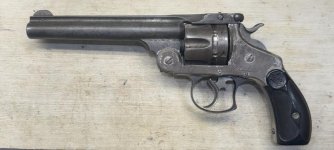- Joined
- Mar 8, 2025
- Messages
- 3
- Reaction score
- 0
Hey all,
First post so I hope I’m in the right spot. I came into possession of a 44 DA Frontier (99% sure), SN: 5980. It had a ton of issues such as the sear spring was snapped, the locking pawl that locks the cylinder when the trigger is pulled back was completely worn away, and the hammer stud is stripped. I have sourced a replacement sear spring and handmade a new locking pawl and the gun operates in both single and DA…kinda. The hammer stud is striped on both ends so it doesn’t like to hold itself in DA because the plate walks its way off the gun when the hammer falls. On the right side, the threads in the frame are completely pulled out and the threads where the cap nut on the left side threads on are gone.
Here’s where I’m stuck. As far as I see, the only possible way to fix this is to turn a new part on the lathe…but with the threads gone on the frame, I need to get a tap as slightly as possible bigger and cut new threads and turn those threads onto the new part. I also need to make the part itself oversize as the hammer is a very sloppy fit on the existing stud.
Am I correct in that this is the only viable option to make this gun shootable again? Virtually all of the chrome is gone, it’s beat up, the right grip is broken where someone before me tried to pry the grip off the stud…but from what I see it’s a relatively rare firearm, it’s a .44-40 (it has the 1 9/16 cylinder), 6 inch barrel in pretty good condition (slight pitting but still strong rifling), and the cylinder looks good. I’d hate to turn it into a parts piece, but I also don’t want to completely ruin it if retapping the frame is a bad idea.
Any opinions? Thanks y’all!
(If pictures are wanted, I can attach them but I’ll have to figure it out)
First post so I hope I’m in the right spot. I came into possession of a 44 DA Frontier (99% sure), SN: 5980. It had a ton of issues such as the sear spring was snapped, the locking pawl that locks the cylinder when the trigger is pulled back was completely worn away, and the hammer stud is stripped. I have sourced a replacement sear spring and handmade a new locking pawl and the gun operates in both single and DA…kinda. The hammer stud is striped on both ends so it doesn’t like to hold itself in DA because the plate walks its way off the gun when the hammer falls. On the right side, the threads in the frame are completely pulled out and the threads where the cap nut on the left side threads on are gone.
Here’s where I’m stuck. As far as I see, the only possible way to fix this is to turn a new part on the lathe…but with the threads gone on the frame, I need to get a tap as slightly as possible bigger and cut new threads and turn those threads onto the new part. I also need to make the part itself oversize as the hammer is a very sloppy fit on the existing stud.
Am I correct in that this is the only viable option to make this gun shootable again? Virtually all of the chrome is gone, it’s beat up, the right grip is broken where someone before me tried to pry the grip off the stud…but from what I see it’s a relatively rare firearm, it’s a .44-40 (it has the 1 9/16 cylinder), 6 inch barrel in pretty good condition (slight pitting but still strong rifling), and the cylinder looks good. I’d hate to turn it into a parts piece, but I also don’t want to completely ruin it if retapping the frame is a bad idea.
Any opinions? Thanks y’all!
(If pictures are wanted, I can attach them but I’ll have to figure it out)

